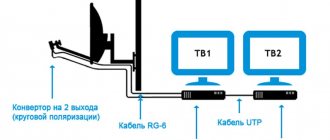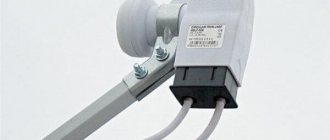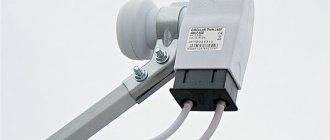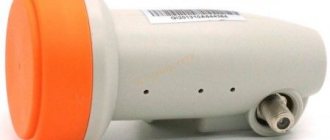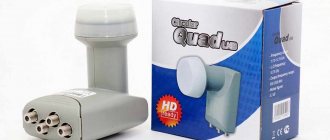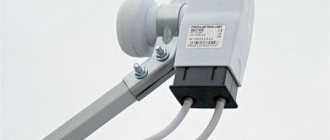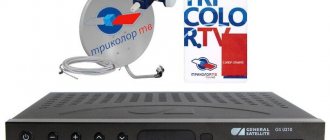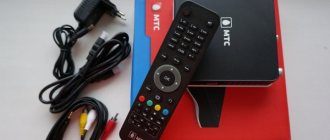If you only have one TV connected in your house, then there are usually no problems. In this case, the television signal enters the television receiver directly from the antenna. The problem comes when you want to watch two or more TVs. You don't have to buy a separate antenna for each of them. A TV cable splitter will come to the rescue - a small-sized device that will completely solve this problem.
TV cable splitter
The “magic” foreign words “splitter” and “diplexer” are called, respectively, an ordinary antenna splitter for digital television or a combiner of two different signals. Among cable operators, these devices are often referred to as “crabs.”
What is an antenna divider?
As the name suggests, an antenna splitter is a device consisting of a compact metal housing with several cable connectors, which serves to distribute the signal to several receivers. Not all splitters perform the same function, so they are grouped together.
Dividers (splitters)
TV cable dividers
The TV signal is evenly distributed to the required number of outputs. Indispensable in home cabling. The most popular type of television accessories among consumers. The main dividers that can be found in stores.
- From 5 to 1000 MHz – used for analogue cable and terrestrial digital television.
- From 5 to 2400 MHz (with power pass) – used mainly for satellite TV.
Couplers
Coupler (TAR)
Sometimes the signal needs to be divided so that the main part of it is sent to one output (OUT), and the small remaining part is sent to a tap (TAP), where the signal will be much weaker than at the main output, where the main part goes. In the future, the same coupler can be connected to this main output, and the signal quality will not be lost. This type of divider is used in daily practice by cable TV providers when installing multi-apartment television networks. A band blocker or cable plug, a type of tap, works on the same principle, which can be useful when separating free and paid channels.
Adders (diplexers)
Adder (diplexor)
Of practical interest is an antenna divider capable of conducting a signal in the opposite direction and thus summing it. Combiners are able to mix signals from several wave receivers with different frequency characteristics into one cable. That is, you can sum up satellite and cable or digital television.
You may be interested in: Connect a monitor to a digital TV set-top box
What types of converters are there?
To choose the right Tricolor TV satellite antenna converter, you need to familiarize yourself with the classification. The device in question comes in two types:
- C-band – frequency 3400-4200 MHz;
- Ku-band – frequency 10700-12750 MHz.
Each of these types has a different frequency range of the received signal. This is where the main difference appears.
C-band devices are used extremely rarely. Therefore, it is almost impossible to find them on the market. When buying a converter, be sure to pay attention to the frequency range of the received signal. This parameter determines the efficiency of the device. Russian satellite television operators prefer Ku-band converters. Therefore, you need to buy such models.
All necessary equipment for setting up Tricolor TV can be purchased from authorized dealers. If you do not buy devices from official representatives of the provider, then check the frequency range of the received signal to avoid problems with the performance of the equipment.
Remember that to watch Tricolor TV channels you need to buy a circular polarization converter. Please note that on the box of devices of this type there is a corresponding Circle marking. Linear polarization models are quite common on the market. The packaging of these devices is marked as follows - Universal. They are not supported by Tricolor.
Active or passive?
From the point of view of electrical parameters, a TV splitter can be passive or active. The first simply splits the signal into two or more outputs, with the significant advantage that it does not require an external power supply. If the incoming signal is strong enough, passive dividers work great without amplification, especially if it is a two-output splitter.
An active splitter is identical in design to a passive one, but differs in the presence of a small built-in amplifier, the task of which is to compensate for the loss of air quality caused by the separation. Splitters with an amplifier require a power supply for the chip. The range of these devices is represented by dividers with the ability to pass the supply voltage. This type of splitter is used when the incoming signal is uncertain or the antenna cable to the TV is long.
Frequent converter breakdowns
As was said at the very beginning, a converter is a device that provides satellite signal reception. Therefore, the failure of this component is accompanied by the appearance of only one, the most important symptom - there is no signal or the quality of reception noticeably drops. Before replacing the satellite converter for Tricolor TV, you need to completely eliminate other faults that are also characterized by this symptom:
- Weather conditions – quite often the signal quality drops and reception problems arise due to heavy rain, snow, wind;
- Damage to the cable - carefully check the wire, it may be broken in a certain area;
- Poor contact - check for correct connections. It is possible that one of the cables is coming off the connector. This can also cause poor reception;
- The smart card is installed incorrectly - this device contains all the personal information about the user, so if it comes off, problems arise with displaying channels;
- The subscription fee has not been paid - it is possible that the funds were not credited to the personal account.
The converter has a fairly long service life. Therefore, this part breaks extremely rarely. Mostly the head fails as a result of mechanical damage.
How do dividers work?
Don't even think about simply connecting two parallel cables to the antenna and getting another signal source. Is it really not possible to connect antenna cables in a simple way? The law doesn't prohibit it, but it's impossible.
Divider circuit and board
An antenna cable, like any other, has a characteristic called “wave impedance.” The cable has its own characteristic impedance, calculated by the designers, so it should only be connected to an object that has the same characteristic impedance. Any attempt to connect the cable “to just about anything” leads to the fact that the main part of the signal, having reached the end of the cable, does not arrive at an object with a different characteristic impedance value, but instead is reflected and goes back along the coax.
The signal will not travel from the cable to an object with the “wrong” characteristic impedance. That is why, instead of a primitive, incorrect connection in the form of twisting, you need to use a coaxial cable splitter, or an antenna signal combiner, with a well-calculated characteristic impedance, the same as that of the cable. Unfortunately, the output signal divided into several receivers has a slightly reduced level.
Knowing how your divider works will help reduce troubleshooting time. For example, if the picture on the screen is torn, it is advisable to start searching for the causes by diagnosing faults in the signal source. You need to check the cable connectors of the splitter and the cable insulation. No metal parts of the cable shield should touch the cable core or clamp.
In what cases is a satellite splitter installed?
If you do not have the opportunity to purchase a converter with independent outputs.
Converters with independent outputs for the Ku-band come in two, four, eight, and sixteen outputs.
C-band converters have two or four outputs.
There is no way to rewire the coaxial cable without damaging property, but there is access to splitters.
Usually, by default, there are splitters for over-the-air antennas.
The satellite you choose operates in the same polarization and subband.
If it is possible not to install a splitter, then there is no need. Please be aware that this will result in signal loss. It’s not always significant, but if the cable footage is quite large and the image on the TV is square, it may be the problem.
How can I check this? Easily. Remove the splitter from the circuit and connect the coaxial cable directly using F-connectors. The picture goes without interruptions, then the splitter is to blame.
Of course, provided that the satellite dish is configured perfectly, and it will no longer be possible to raise the signal.
It is important to know that there are different splitters for terrestrial antennas and for satellite ones. What is the difference? In the range of processed frequencies. Terrestrial splitters have a range of 5–1000 MHz, satellite splitters have a range of 5–2300 (2400,2500) MHz.
The satellite splitter must have a power feedthrough.
Satellites suitable for splitter wiring
Express AT1 at 56.0°E
How to choose the right splitter for TV
When buying a TV antenna splitter, the first thing you need to pay attention to is the number of output ports. If there are three television receivers in the house to which you want to connect the television signal and divide it, then, of course, you will need a splitter with three outputs. This is its main visual characteristic and you can hardly go wrong. A reasonable solution would be to buy a divider with an additional output, so to speak for the future.
You may be interested in: What does an HDMI cable look like?
Domestic and foreign manufacturers supply the market with a lot of splitters, from a double divider to a 16-port splitter. Their housing contains markings indicating the operating frequency range and the designation of inputs and outputs. Check whether the selected microdevice supports the required frequencies? The most common operating range is 5-860 MHz, which makes it easy to distribute a DVB-T2 television signal while maintaining broadcast quality. The channel frequency display function on your TV will help you not to make a mistake with the frequencies. The maximum frequency of one of the channels must fall within the frequency range of the divider.
- A criterion such as attenuation also deserves attention. Its parameters are indicated in decibels on the device body or in its instructions. Of the two suitable splitters, choose the one with the lower attenuation value.
- You already know about active and passive dividers. When purchasing an active model, your task is to decide on the type of power source (regulated or not) and make sure there is an outlet in the chosen location.
- Dividers vary in the way the cable is connected. You can find devices with screw terminals (works with any cable diameter), with threaded connections, with coaxial connectors, and those where the cable needs to be soldered.
Take a look at the selected divider from the aesthetic side. The geometry and dimensions of this device can be different; it’s up to you to decide whether to put it on display or give it an inconspicuous place. If you plan to mount it on a wall, you need a housing with mounting holes.
Those craftsmen who decide to make television wiring in their home themselves may be tempted to create a crab with their own hands. Technically, this is not difficult if you understand what the divisor consists of. But even if you have the necessary transformers and capacitors in your arsenal, as well as the housing of the future divider, do not complicate your life. Your product will only serve an analog signal, and may be useless for satellite and digital TV. But purchasing ready-made “crab” from leading manufacturers is a reliable and long-term solution.
Basic parameters of converters
The standard Tricolor converter is equipped with 1 output. This means that only one TV can be connected to such a device. If you plan to connect several TVs, then be sure to pay attention to the number of available connectors. Today, subscribers are offered several options:
- Single – 1 connector.
- Twin – converter with two outputs.
- Quad – a device for connecting four TVs.
- Octo – 8 outputs.
The logic is simple; the number of connectors determines how many TVs you can connect to a satellite dish. If you plan to connect multiple TVs, then you will need more cables. For example, if you want to connect 3 TVs, then you need to run the same number of cables from the dish to the house.
There is an alternative way to connect several TVs at once. To reduce the number of connectors in the converter and save money on laying multiple cables, you need to use a satellite signal divider. However, there are certain disadvantages. Despite its innovation, the use of a divider causes a decrease in signal quality. Interference appears - at least five decibels.
Therefore, the best way to connect several TVs to satellite broadcasting is to purchase a converter with the appropriate number of connectors. You will be able to prevent interference. You will be able to fully appreciate the high-quality image and clear sound. It should also be noted that the divider cannot be used in cases where you have subscribed to several satellite TV operators at once.

